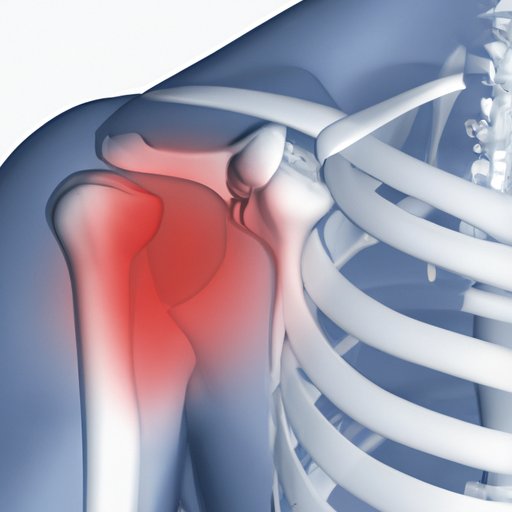I. Introduction
The labrum is a critical piece of cartilage in the shoulder joint that provides stability, cushioning, and range of motion. Any injury to the labrum can lead to pain, dislocation, or reduced mobility, which can severely impact daily life and athletic performance.
II. What is a Labrum?
The labrum is a ring-shaped cartilage that encircles the socket of the shoulder joint, providing structural integrity and support to the head of the humerus. It is made of fibrous tissue and is a crucial stabilizer of the shoulder joint.
The labrum also acts as a shock absorber, distributing the load across the shoulder joint and preventing the bones from rubbing together, thereby reducing wear and tear and protecting the joint from damage.
III. The Role of Labrum in Shoulder Joint Stability and Movement: Science Explained
The labrum plays an essential role in the stability and movement of the shoulder joint. It helps to maintain the proper alignment of the humerus bone on the glenoid, which is the joint’s socket. Moreover, it increases the joint’s surface area, allowing a wider range of motion.
A healthy labrum contributes significantly to the movement of the shoulder joint by enabling a combination of rotation, gliding, and sliding movements of the ball and socket joint. A solid and secure labrum allows you to have a stable and functional shoulder joint.
If the labrum is torn, the shoulder joint becomes unstable, resulting in pain, weakness, and a diminished range of motion. If the condition continues untreated, the joint may dislocate or develop arthritis, leaving you with limited shoulder joint function.
IV. Labrum Tears: Causes, Symptoms, and Treatment Options
The most common causes of labrum tears include direct impacts to the shoulder joint, repetitive motions that put strain on the joint, and wear and tear due to aging. Some of the common sports activities that can lead to labrum tears include weightlifting, football, and baseball.
The symptoms of a labrum tear may include a popping or clicking sensation in the shoulder joint, pain, weakness, and limited range of motion. Sometimes, labrum tears do not cause immediate pain but can develop over time due to the constant strain on the shoulder joint.
The treatment for labrum tears will depend on the severity of the tear and the patient’s overall health. In mild cases, non-surgical treatment options such as rest, physical therapy, and anti-inflammatory medication may be suggested. Severe tears may require surgical repair, including arthroscopic labrum repair, which involves removing or repairing the torn section of the labrum.
V. Anatomy 101: Understanding the Different Types of Labrum and Their Functions
There are two different types of labrum found in the shoulder joint – the glenoid labrum and the biceps labrum. The glenoid labrum plays a critical role in shoulder joint stability, while the biceps labrum primarily stabilizes the upper biceps tendon.
The glenoid labrum covers the glenoid socket, and it allows for the movement of the humeral head. The biceps labrum prevents the biceps tendon from slipping out of its groove, thereby providing stability to the upper arm.
VI. The Labrum and Sports Injuries: A Close Look at Their Relationship and How to Prevent Them
Sports activities can lead to labrum tears in athletes involved in overhead motions such as throwing and weightlifting. Football and baseball players are at a higher risk of developing labrum tears due to the nature of their sports activities.
Preventing labrum tears during sports activities must involve proper warm-up exercises and building strength through regular training. It is also essential to avoid overuse and prevent putting too much pressure on the shoulders during repetitive motions.
VII. Labrum Surgery: What to Expect Before, During, and After the Procedure
Labrum surgery is often suggested for patients with severe labrum tears that cannot be treated with non-surgical approaches. The surgery could cause discomfort and pain for the patient, but it can provide significant relief for those with long-term labrum-related pain.
Before the procedure, the patient will undergo a comprehensive assessment by the surgeon to determine their overall health and assess the damage to the labrum.
The surgical procedure will involve repairing the torn section of the labrum and stabilizing the humerus bone in the socket. The recovery process after the procedure will include post-operative physical therapy and taking prescribed medication to manage any pain.
VIII. Managing Labrum-Related Pain: Conservative Treatments and Exercises to Ease Discomfort
Conservative treatments such as physical therapy, non-steroidal anti-inflammatory drugs, and rest can be effective in reducing the pain associated with labrum tears. Physical therapy involves rehabilitating the joint through targeted exercises that can rebuild strength and improve range of motion and flexibility.
It is essential to involve your doctor, physical therapist, and trainer in developing a rehabilitation program to help reduce and manage pain. A well-planned rehab program may enable the patient to return to their daily activities sooner while also preventing further injury to the labrum.
IX. Conclusion
The labrum is a vital component of the shoulder joint, responsible for stability and mobility. Labrum tears can result in significant pain, reduced range of motion, and severely impact daily life and athletic performance. It is essential to understand the different types of labrum, their functions, and the treatment options available for labrum-related injuries.
By building shoulder strength through targeted training, taking preventive measures, and seeking appropriate treatment options, you can reduce the risks of labrum injuries and manage pain associated with labrum tears.
